Recent Articles
Popular Makes
Body Types
10 Reasons the 2019 Ford F-250 Won the AutoWeb Buyer’s Choice Best Heavy-Duty Truck Award
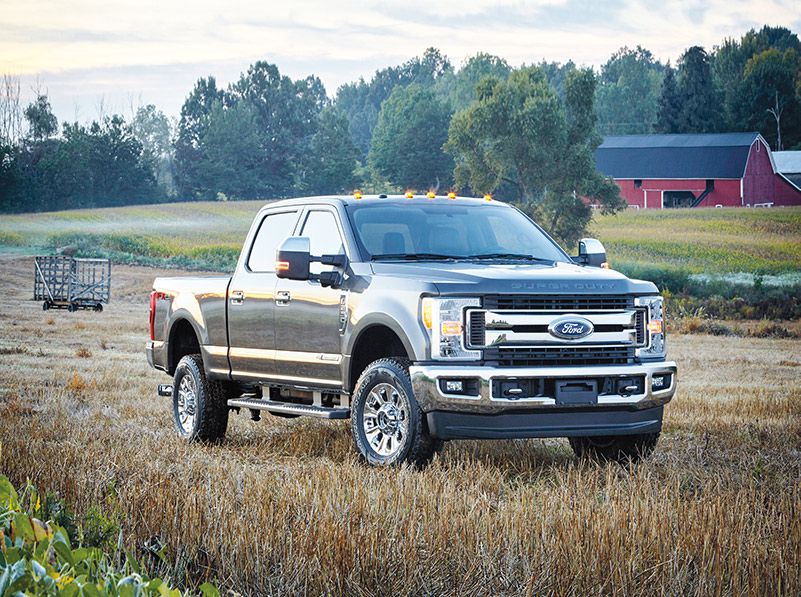
2019 Ford F 250 front three quarter
Heavy-duty trucks used to be strictly commercial. Stark and stripped down, they were work trucks designed and built to be used on job sites. Now, all that has changed as buyers are choosing heavy-duty trucks for everyday and casual use. If a rugged full-size pickup was good, a heavy-duty truck was better. With the influx of casual users came the expectation that heavy-duty trucks not only should be capable, but should offer comfort, convenience, and style as well.
The 2019 Ford F-250 Super Duty evolved from a commercial work truck into something more. Competing with new versions of the Chevrolet Silverado HD, GMC Sierra HD, Ram 2500, and Nissan Titan HD, Ford's F-250 brings successful innovations from the light-duty F-150 to the heavy-duty platform and adds some twists of its own.
Here are ten reasons the 2019 Ford F-250 reigns as the AutoWeb Buyer’s Choice Best Heavy-Duty Truck.
10) Like the F-150, the F-250 Super Duty uses aluminum body construction.
When the current-generation F-150 light-duty truck was introduced, one of its big innovations was aluminum body construction. When the latest generation F-250 heavy-duty truck debuted as a 2017 model, it followed suit with an aluminum body all its own. In fact, the Super Duty body is identical to the F-150 body from the A-pillars to the C-pillars. Previously, all Ford pickups were built with steel bodies. Aluminum is more rigid than steel, and much lighter – both advantages for truck construction. The change from steel to aluminum saved 350 lbs on F-250 – weight that was redistributed into the frame, for even greater strength and carrying capacity.
Another advantage of an aluminum body is that aluminum doesn’t rust like steel does – which means that aluminum-bodied F-250 trucks have a chance for extended service life in harsh climates.
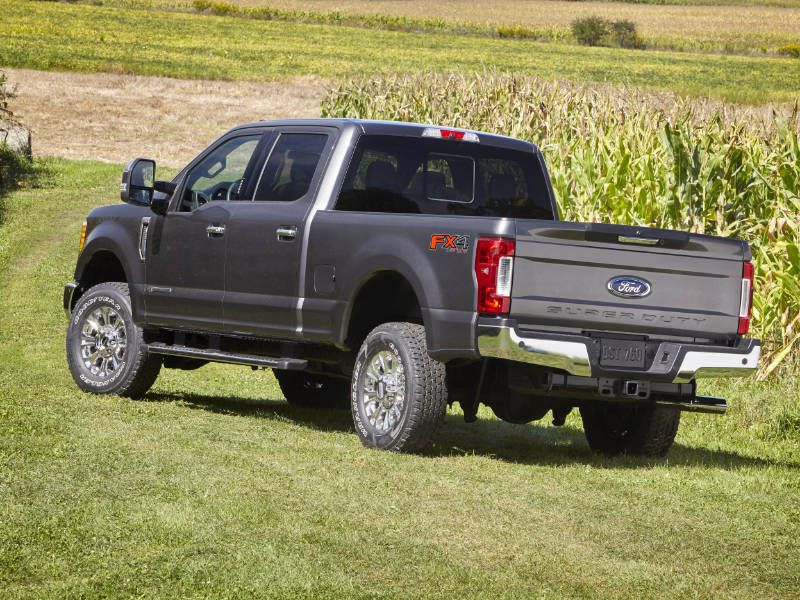
Photo by Ford
9) The F-250 now features a fully boxed frame.
When Ford engineers were looking for opportunities to save weight, they concentrated on the body and powertrain of the F-250. But they actually increased the weight of the frame, constructing a fully boxed frame. Previous generations of F-250 used steel C-channel rails, while the current generation uses square-walled rails, essentially closing off the mouth of the C-channel for improved stiffness and strength. Additionally, the frame is taller and thicker than it was before, and uses 10 crossmembers that contribute to rigidity and prevent racking.
The increased weight of the frame balanced against lower weight of the body and other components effectively lowers the F-250’s center of gravity, which contributes to improved handling and overall driving quality.
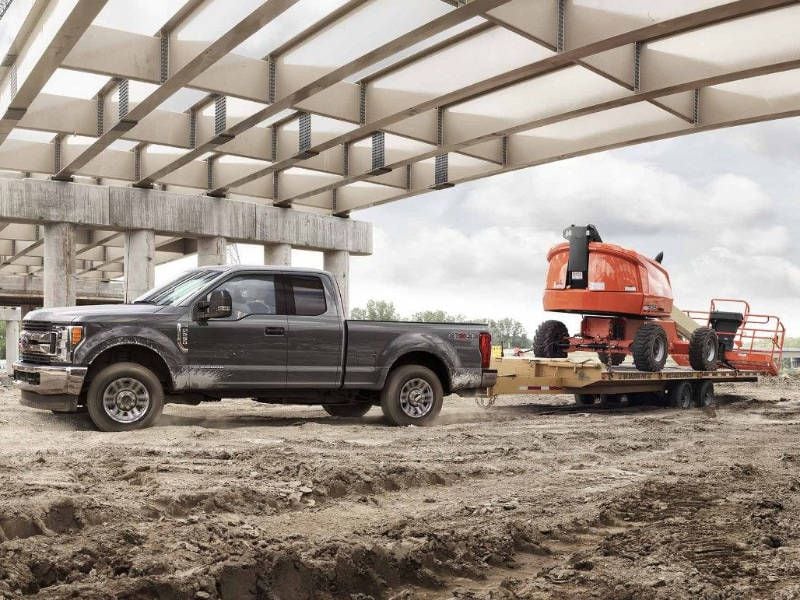
Photo by Ford
8) The interior of the F-250 can reach luxury levels.
Because the F-250 and F-150 are nearly identical from A-pillar to C-pillar, it made sense to make all of the comfort and convenience features from the light-duty world available to the Super Duty. That means available premium audio from Bang & Olufsen, navigation, push-button keyless ignition, leather seating surfaces, heated and ventilated front seats, 10-way power front seats with memory, tilt-and-telescope steering wheel, and more.
Optional FordPass Connect includes an in-vehicle AT&T 4G LTE Wi-Fi hotspot to connect up to 10 devices at once – and extends coverage up to 50 feet outside of the vehicle, too – perfect for worksite use.
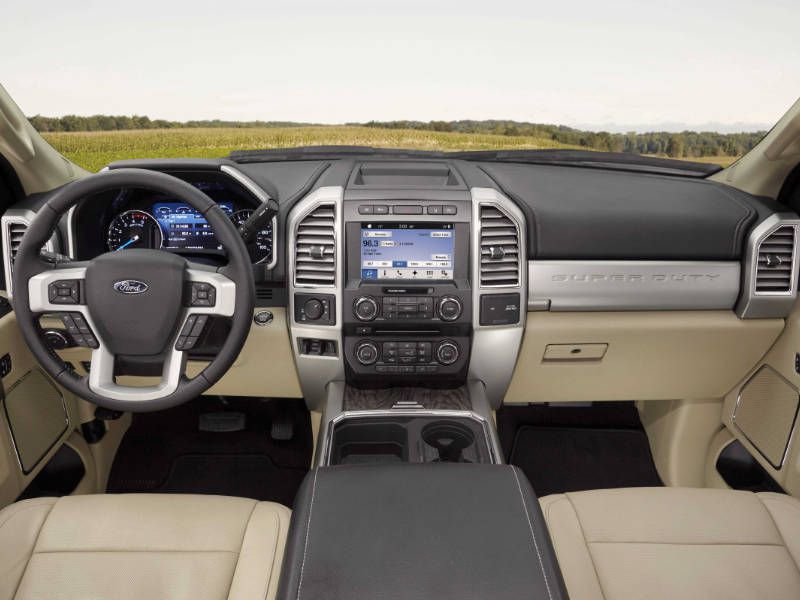
Photo by Ford
7) The F-250 offers two engine and transmission choices (one gas/one diesel).
The monster engine available for F-250 is a 6.7-liter Power Stroke turbodiesel V8. It is rated to produce 440 hp and 925 lb-ft of torque. Torque is the twisting power that an engine can apply, and it is very important in initiating the first movement of a load. More is better, and 925 lb-ft is a massive amount of torque. The diesel uses a six-speed automatic transmission and can be ordered with rear-wheel drive or four-wheel drive.
Diesel isn’t for everybody, so there’s a 6.2-liter gasoline V8 engine available, too. It is tuned to deliver 385 hp and 430 lb-ft of torque running on regular unleaded or E85 gasoline. Like the diesel, the gas engine is mated to a six-speed automatic with either rear-wheel drive or four-wheel drive.
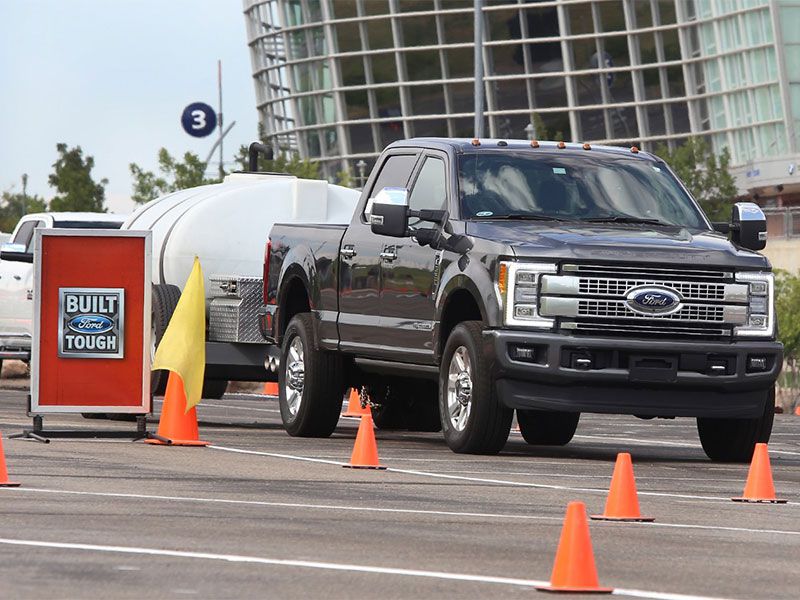
Photo by Ford
6) The F-250 takes truck styling into sophisticated territory.
Though F-250’s body is identical to F-150 from the A-pillar to the C-pillar, it has a unique front fascia, hood and fenders. Some of the styling elements of F-250 are a case of form following function. The hood on F-250 is taller than the hood on F-150, for example. This height difference is designed to accommodate bigger and taller engines.
A stamped SUPER DUTY logo in the center nose of the truck and a big, bold Ford blue oval badge in the center of the beefy grille leave little doubt of the truck’s pedigree. Signature C-shaped lighting arrays bracket the grille, helping to define the F-250’s face. Tall wheel arches hint at great wheel travel and capability. An inset vent below the A-pillar displays an outline of the F-250 moniker. Additionally, eleven exterior and six interior colors are available, a wide palette for a work truck.

Photo by Ford
5) The F-250 has a beefy suspension that also is smooth and compliant.
Heavy-duty trucks make their reputations based on strength, but a quiet, smooth ride is what makes F-250 easy to live with. F-250 uses beefy front stabilizer bars and collars with cast radius arms and advanced rear joints and bushings. These components work together as a system that not only can handle great weight, it also delivers a quieter, smoother ride than previous F-250 iterations.
One of the big challenges for a heavy-duty truck’s suspension is maintaining ride quality in both laden and unladen states. Sometimes the stiff setup required for load management can result in excessive rebound when the bed is empty. F-250’s suspension strikes a perfect balance between the two states, and delivers a composed ride with or without a load.
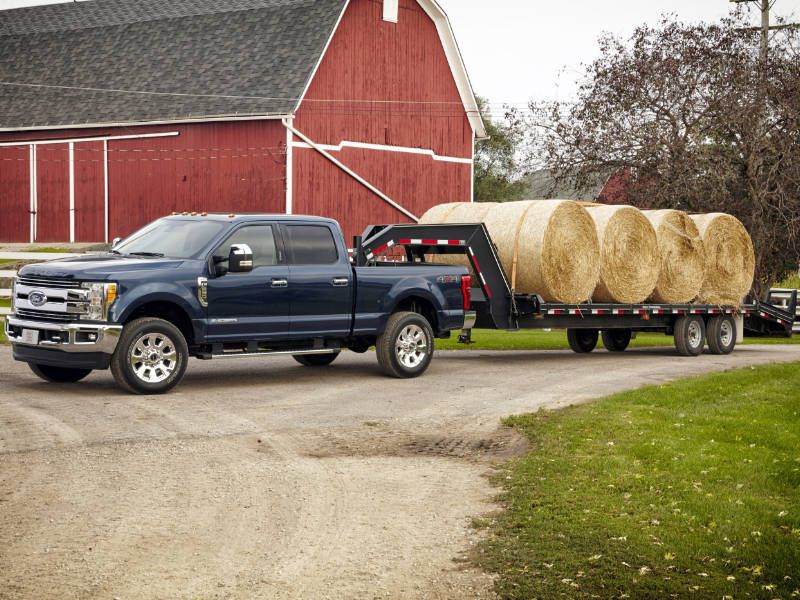
Photo by Ford
4) The F-250 is available with Adaptive Steering.
The standard steering setup for F-250 is tried and true: A hydraulic power steering pump connected to a recirculating ball setup. It works well – but the optional Adaptive Steering system can improve operation dramatically. The same pump/ball system is in place, but Adaptive Steering adds an electric motor and worm gear in the steering wheel itself. This allows for dynamic computer control of the steering ratio. That means that the computer can read the driving situation and adjust steering ratio on the fly for the best performance.
In a parking lot at low speed, small movement of the steering wheel translates into big action at the wheel; at highway speed, the same small input at the steering wheel translates into miniscule action. This dynamic adjustment occurs transparently, and shows itself both as agility in tight maneuvers and as smooth driving on the highway.
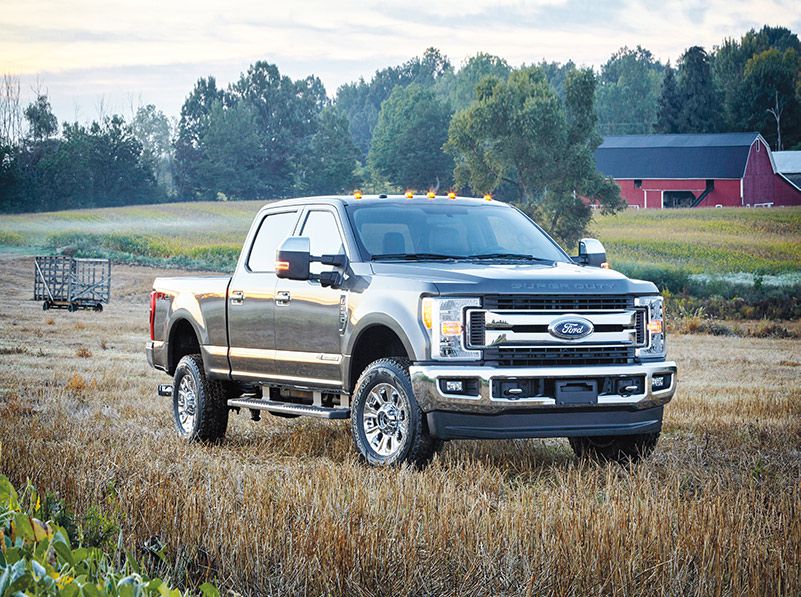
3) The F-250 rules in towing and cargo hauling.
Towing is a very important feature for Super Duty, as Ford reports that 90 percent of owners use their trucks to tow. F-250 can tow up to 18,000 lbs when set up for conventional towing. The frame also can be ordered with the setup for gooseneck or fifth-wheel towing.
Trailer sway control is standard on Super Duty, and an array of up to seven cameras can be specified, all connected to the dashboard screen for multiple views. There’s even a wired camera slot, available for mounting on the rear of a trailer. The camera system includes the capability for some coaching, providing simple prompts for hookup and backing.
F-250’s aluminum bed can handle up to 4,200 lbs of cargo. Integrated tie-downs are standard, and BoxLink locking cleats allow for the use of E-Track accessories for great cargo management. LED box lighting is available from the factory, too.
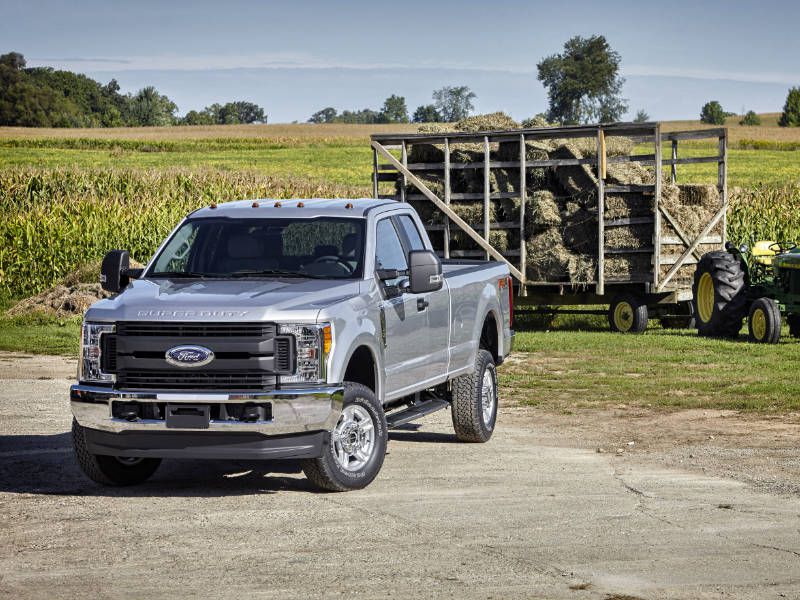
Photo by Ford
2) The F-250 has access to driver assistance features rivaling those of an SUV.
As more and more buyers use Super Duty trucks to transport their most precious cargo – family and friends - Ford has made sophisticated driver assistance features available. The anchor of driver assistance is a system of sensors that scan the environment for obstacles and hazards.
Using these sensors, Adaptive Cruise Control becomes available, capable of maintaining not only a pre-set speed, but also a set distance from the vehicle ahead in the roadway. Lane Departure Warning scans lane markers and alerts the driver if the vehicle drifts. Blind Spot Information System warns if a vehicle lurks in the Super Duty’s blind spot – and even can be calibrated to warn of obstacles in a towed trailer’s blind spot. The system is so advanced that it can store up to 10 trailer calibrations in its memory.
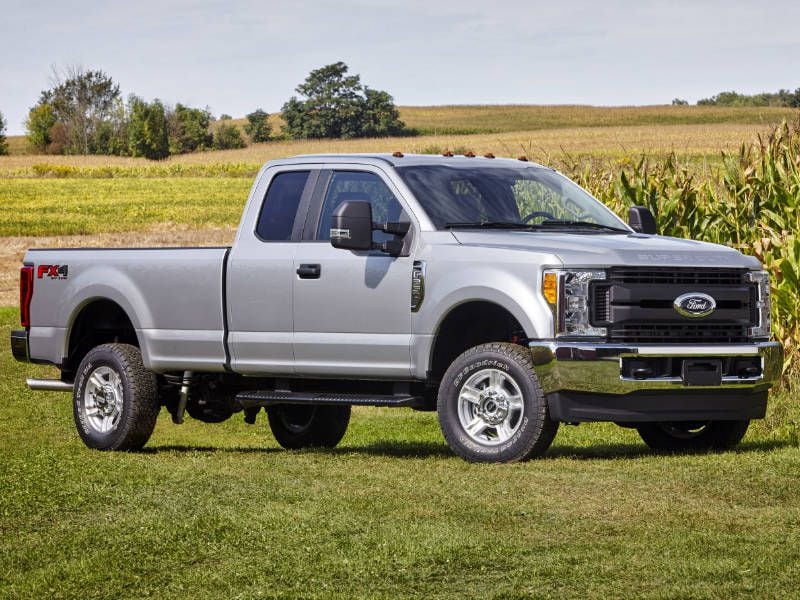
Photo by Ford
1) The F-250 range is broad and accessible.
There are six models of F-250 for 2019: XL (starting at $33,150); XLT (starting at $37,365); Lariat (starting at $46,140); King Ranch (starting at $56,910); Platinum (starting at $63,335); and Limited (starting at $80,240). Three cab sizes can be selected: Regular (XL and XLT), SuperCab (XL, XLT, and Lariat), and Crew Cab (all trim levels). A choice of 6.75-foot or 8-foot bed can be matched to the SuperCab and Crew Cab models. Regular Cab models are 8-foot bed only. All-wheel drive adds $2,800. Choosing a diesel over gasoline engine adds $9,120. An amazing selection of packages, both bundled and a la carte, are available to customize your F-250 to your exact needs and desires.
With this wide range of pricing and choices, it’s easy to see 10 Reasons the 2019 Ford F-250 Won the AutoWeb Buyer’s Choice Best Heavy-Duty Truck Award.
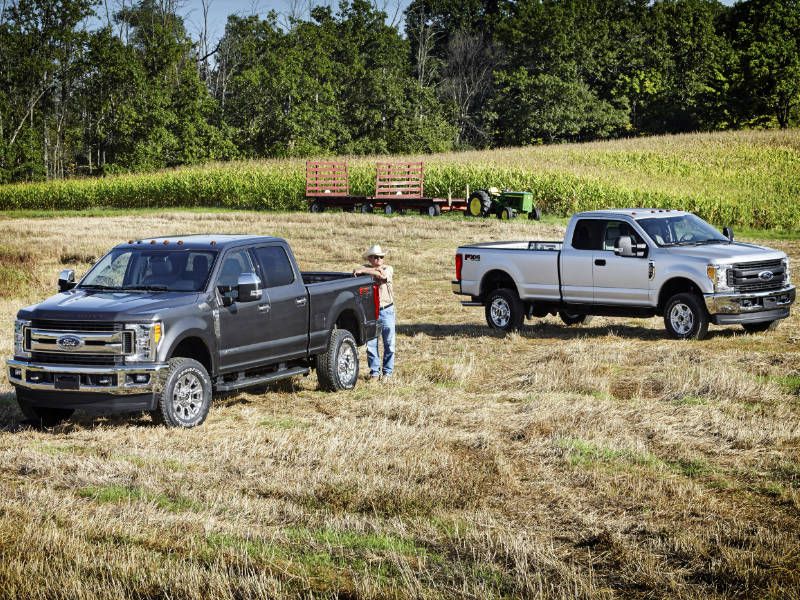
Photo by Ford